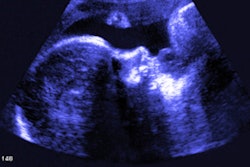Using ultrasound prior to operative vaginal birth leads to improved neonatal outcomes, according to research published March 11 in American Journal of Obstetrics & Gynecology MFM.
A team led by Sasha Skinner, MBBS, from Monash Health in Victoria, Australia, found that compared to cases where ultrasound was not used, implementing a safety protocol that included intrapartum ultrasound was tied to fewer infants being delivered in an unexpected position and a reduction in neonatal morbidity.
“Our experience found that clinicians were receptive to upskilling in [ultrasound] to determine fetal head position,” the Skinner team wrote. “Intrapartum ultrasound is portable, easily accessible in many birthing units and improves the accuracy of determining fetal head position, which may reduce neonatal morbidity.”
Previous reports indicate that poor outcomes from operative vaginal birth can be caused by a variety of factors, ranging from failure to recognize malposition, breakdowns in interdisciplinary communication, and lack of compliance with accepted guidelines, the researchers noted.
Skinner and colleagues implemented a safety protocol that included routine intrapartum ultrasound, a structured time-out, and a procedural checklist with the goal of reducing maternal and perinatal morbidity from operative vaginal births. For the study, the researchers compared births at Monash Health where intrapartum ultrasound was and was not used during the safety protocol implementation period.
The study included 1,205 operational vaginal births (for example, fully dilated cesarean sections) performed between 2022 and 2023. Of the total births, 509 included ultrasound while 696 did not.
Over the study period, for operative second-stage births, ultrasound uptake increased from 26% to 60% (p < 0.001), structured time-out use increased from 21% to 58% (p < 0.001), and checklist use spiked from 33% to 80% (p < 0.001).
The team found that using ultrasound led to significantly more forceps births and a reduction in vacuum births. Additionally, the modality led to fewer infants being delivered in an unexpected position and a reduction in composite neonatal morbidity.
| Comparison between births that used/didn't use intrapartum ultrasound | ||||
|---|---|---|---|---|
| Type of birth | No ultrasound | Ultrasound | Adjusted odds ratio | p-value |
| Forceps births | 58% | 67% | 1.35 | 0.021 |
| Vacuum births | 24% | 32% | 0.77 | 0.059 |
| Deliveries in unexpected positions | 2.2% | 0.2% | 0.08 | 0.019 |
| Neonatal morbidity | 25% | 22% | 0.73 | 0.031 |
Finally, the researchers reported no significant differences in fully dilated cesarean section cases or maternal morbidity.
The study authors highlighted that while the jury is out on whether routine intrapartum ultrasound or targeted use is better for improving maternal and neonatal outcomes, the modality’s use is “rapidly gaining popularity” for clinicians.
“Our study reflects the ‘real-world’ clinical use of intrapartum ultrasound in busy maternity units involving several health professionals with varying skill in ultrasound, which has differed to many previous studies where intrapartum ultrasound was only performed by experienced ultrasound users,” the authors wrote.
The study can be found in its entirety here.



















